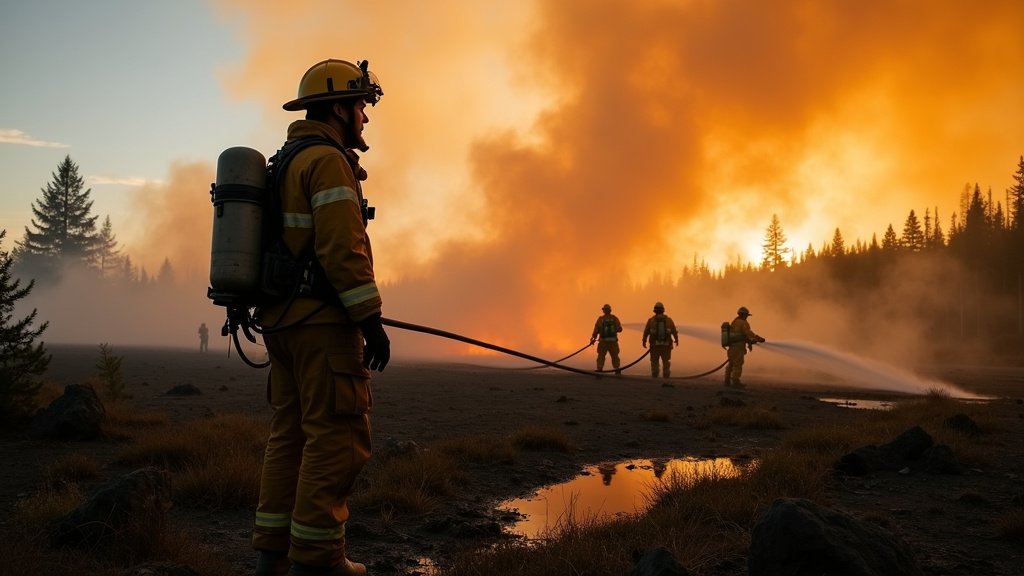Oregon Concludes Milder 2025 Fire Season Amidst More Ignitions, Significantly Reduced Acreage
Oregon officially declared the end of its 2025 wildfire season on October 17, a period marked by a notable paradox: a higher number of individual fires compared to the previous decade, yet a dramatic reduction in the total acreage burned. This outcome, viewed as a significant success by state officials, stands in stark contrast to the historically devastating fire seasons of recent years, particularly 2024. The Oregon Department of Forestry (ODF) and Governor Tina Kotek largely attribute this more favorable result to aggressive initial attack strategies, the dedication of firefighting personnel, and opportune weather conditions.
A Significant Turnaround from 2024’s Record Losses
The 2025 fire season concluded with an estimated 2,569 wildfires across the state, burning approximately 288,774 acres as of October 16. This figure is a stark improvement from the 2024 season, which saw an alarming 1.8 million acres consumed and resulted in a record 17 conflagrations declared. The severity of recent fire seasons has prompted proactive measures, with Governor Kotek invoking the Emergency Conflagration Act eight times in 2025 to deploy state resources to critical incidents. This act allows the state fire marshal to mobilize resources beyond local capabilities when life, safety, and property are threatened.
Aggressive Initial Attack Strategy Proves Effective
A cornerstone of Oregon’s success in limiting acreage burned in 2025 was its focus on aggressive initial attack strategies. This approach emphasizes rapid and decisive action to extinguish fires while they are still small, preventing them from growing into uncontrollable blazes. Michael Curran, ODF Fire Protection Division Chief, highlighted the effectiveness of this method, noting that many fire starts this year went unnoticed by the public due to swift suppression efforts. “In 2025, 94 percent of fires on ODF-protected lands were put out at 10 acres or fewer,” Curran stated, underscoring the success of this strategy. Jessica Neujahr, ODF spokeswoman, also pointed to the rapid response of agencies in tackling blazes early to prevent significant spread.
Multifaceted Factors Influencing the Season
While rapid response was critical, a confluence of factors contributed to the relatively mild outcome of the 2025 fire season. Projections early in the year suggested potential for conditions similar to the severe 2024 season, creating widespread concern. However, the season benefited from the dedication and preparedness of firefighters who were motivated by lessons learned from previous years. Favorable weather conditions, including mid-season rains and cooler temperatures, also played a significant role in suppressing fire activity, alongside an element of luck. Governor Kotek had declared a State of Emergency on July 16, 2025, acknowledging the critical fire danger posed by extreme temperatures and mobilizing state resources in anticipation of worsening conditions.
Key Statistics and Fire Origins
On lands protected by the ODF, 1,135 fires burned over 24,275 acres. Statewide, the total number of fire starts on ODF-protected lands saw an increase of about 100 compared to 2024, but the acreage burned was drastically lower. Analysis of fire causes indicates a near balance between lightning-ignited fires and human-caused fires, with 1,294 fires attributed to lightning and 1,275 to human activity across Oregon in 2025.
Notable Incidents Amidst a Milder Season
Despite the overall mild nature of the 2025 season, Oregon did experience several significant fires that required substantial response and resource mobilization. These included the Rowena Fire and the Burdoin Fire in June, which caused considerable damage to homes along the Columbia River. The Moon Complex Fire and the Cram Fire also necessitated the invocation of the Emergency Conflagration Act due to threats to life, safety, and property, highlighting that even in a less severe year, significant wildfire events can occur. The Flat Fire in Central Oregon also required extensive resources and management attention.
Looking Ahead: Continued Vigilance and Prevention
As the 2025 fire season officially concludes, Oregon’s focus is shifting towards prevention, fuels reduction, and comprehensive planning for the future. While the reduced acreage burned this year offers a crucial respite, long-term trends indicate that the risk of severe wildfire seasons, exacerbated by climate change and fuel accumulation, remains a persistent challenge. Officials continue to stress the importance of public awareness, preparedness, and adherence to fire restrictions to mitigate future risks. The success of the 2025 season serves as a testament to the effectiveness of proactive strategies and the resilience of Oregon’s firefighting efforts, but underscores the ongoing need for vigilance in the face of evolving wildfire conditions.
Further reading: Related News on Google



